Columbus: The New Midwestern Star
Columbus, Ohio is by far the best performing city in Ohio. In a state that has become a byword for the challenges and pain of de-industrialization, Columbus is a clear standout, with strong economic and population growth.
A lot of the analysis of what makes Columbus different from Cleveland, Toledo, Dayton, Youngstown, and even Cincinnati often starts out by noting all the advantages Columbus had. It is the state capital. Ohio State University is there. It was not a traditional heavy manufacturing center, and so did not have that legacy to overcome.
But what strikes me about Columbus is not all the advantages it has, but rather the handicaps it has when compared to other Midwestern standouts like the Twin Cities:
In addition to just having a generic name shared with cities in various states, there is really nothing that would put Columbus on the mental map of the world. Louisville has the Kentucky Derby. No matter what else people may or may not know about Louisville, everyone knows the Derby and that it is in Louisville. It's a similar story for the Indianapolis 500. But Columbus? Nothing.
I caused some pain for myself on a Columbus message board by suggesting that outside the United States, especially in Europe, Columbus, Indiana probably has better brand recognition than Columbus, Ohio and that among a certain social set if you just said, "Columbus", the Indiana town is what would come to mind. This is because Columbus, Indiana has one of the world's most important collections of modernist architecture by a who's who of key architects. (It is an absolute must visit, incidentally, and be sure to sign up for the bus tour at the visitor's center). It has an international reputation for this.
So I think in looking at Columbus, you need to be able to see its success in terms of the big headwinds the city faces in some respects. This renders its performance all the more impressive. Consider:
Columbus also seems to have benefited from longstanding enlightened leadership. Back in the 1950's or so, one of their mayors made a key decision. He refused to extend water service to places that did not agree to be annexed. Thus Columbus was able to expand geographically where most Midwestern cities got hemmed in. So while it does not have a city-county merger in effect, Columbus takes up a huge amount of the county, with a population in the city proper of over 700,000 people. Ohio has very favorable annexation laws for cities that control utilities. If you get utility service from a city, you can't stop them from annexing you - and you can annex across county lines, something that Columbus has already done. While it now does have cities like Dublin ringing it in some respects, there seems to be a recognition that there needs to be room for the city to continue to grow, and from what I've seen, annexation boundary agreements with suburbs continue to provide more or less unlimited possibilities for Columbus to continue expanding.
The corporate community is robust and engaged. Columbus seems to have a very strong economic development mindset, and a pro-business attitude. The local corporate community has been very active in things like the development of the Arena District, and has pumped a lot of money into the downtown. There can be complaints, probably with some degree of legitimacy, that development policies are overly corporate driven, but this is true everywhere. Columbus has also notably maintained a large white collar work force.
The government and citizen base seems to be supportive of fairly progressive public policies. I noted recently how citizens of the city have routinely voted for bond levies to fund various civic improvements. Even in this recession, there was just a vote for a parks levy that is partially to maintain operations, but also partially to expand the parks. Like many cities, Columbus has a lot of overgrown country roads that haven't been upgraded, but it is trying. Last year Columbus spend $50 million on adding new sidewalks, for example. There have been other bond issues and many of them are focused on things like sidewalks and other projects to improve the quality of the overall city's general infrastructure, not a handful of splashy mega-projects. As I've long said, the mark of a great city is in how it treats its ordinary spaces, not its special ones. Every small town in America makes its Main Street look nice. But the ordinary street is much more important. Columbus seems to get that.
The one thing that has failed in Columbus is light rail. It was voted down. Actually, I think that's probably a good thing since while improved transit is certainly needed there, a very expensive light rail system probably isn't a fit for Columbus.
Columbus, like most cities, has an urban core that has many challenges. There are a lot of areas of the old city of Columbus that are as decayed as any other place. But Columbus also has a lot of urban gems in its central city as well. German Village might well be the best historic district in the United States. It is truly incredible and a must visit. While the downtown isn't that exciting, areas like the Short North and the entire continuous strip of urbanized development north along High St. through the University campus up to Worthington is impressive. There are a number of smaller Franklin County suburbs that are super-cool "old school old money" type places in their appearnce. Newer places like Dublin are starting to turn it on.
So what does Columbus need to do moving forward?
1. It needs to strengthen its brand. I wrote a lot about strengthening the brand of Indianapolis in this blog, but that city is one I know intimately. I don't know Columbus well enough to judge what its essential character might be, but ultimately a real brand image needs to spring from the native soil. Columbus can't be a world class city unless it is a world class Columbus. Great cities, like great wines, have to express their terroir. Trying to graft coolness onto a place apart from its essential character only looks pathetic. I think Columbus is still stuck in a insecure phase where it is engaging in braggadocio to make itself seem like it is one of the cool upperclassmen. The best example here is the city calling itself "The Indie Arts Capital of the World". There is actually some goodness in this. I noted the city's relatively weak high culture institutions, so focusing on indie arts makes sense. But is this brand likely to play in Chicago? I don't think so. Nor do I think it works as a aspirational statement since it seems at odds with local character and difficult to achieve. This won't be easy. The name Columbus itself is a bit of a millstone as I noted. But I think it can be done. It's going to take a lot of digging deep and working hard, and finding an inner confidence in what Columbus is as a city.
2. Infrastructure is a problem. Columbus is growing and needs to expand its infrastructure to keep up and also improve and maintain its legacy infrastructure. The problem is that key portions of Columbus' legacy infrastructure require very expensive upgrades that will likely suck up all available funds. This will hurt it if something creative isn't found. For example, ODOT is going to spend over a billion dollars reconstructing part of the inner loop downtown. That is desperately needed since the road is unsafe, but is unlikely to add to Columbus' competitive advantage as a city. And that's a billion that can't be spent on other things. Some locals want to put caps on the freeway to mitigate the "noose effect" it has on downtown. These are very expensive and have been considered too costly to include. This ought to be reconsidered. Yes, it won't be cheap. But cutting out every "value added" element from a project to keep the cost down means you could ultimately end up with still an ultra-expensive project, but one that has little real boost for the city. If you've got lemons, you need to make lemonade. If you're going to hold your nose and fix a problem like this, you might as well pinch a little harder and do the job right so that you get some actual value out of it.
3. Improve the quality of urban design. Columbus isn't bad, but its built environment is rather generic. It needs to improve the quality of its architecture and public space, and what's more use design as a way of expressing its brand. This is a huge opportunity area for cities like Columbus to create a differentiated physical environment at modest incremental cost. It seems to be something that doesn't register with people, however. Indianapolis, as I've noted, has some simply superb examples of design in a handful of locations - but refuses to do anything with them. I am utterly befuddled by this. Even Chicago is backsliding on this front. It's a big opportunity area for Columbus.
4. Tune-up the economic development engine. Columbus is doing well here - it's hard to argue with the results. But I think a pro-active scan to find some specific niches where Columbus can create sustainable competitive advantage and get the benefits of being a first mover are would be good to do. I think the future is about micro-clusters made up of many small and medium sized businesses that in aggregate will add up to what say a single major HQ or factory might have had. Only looking at general mega-clustures like life sciences is not enough. Also, OSU brings huge numbers of outsiders to the area for four years. They probably had a great time. How can the city turn the OSU university alumni network into an urban alumni network?
On the whole, I think Columbus is rocking and rolling. Because of its weak name recognition and the fact that it is in Ohio, I think it flies almost completely under the radar. But this an impressive city and one that is arguably the best positioned of any Midwestern metro to really prosper in the 21st century economy. For those of you who haven't been to Columbus, I strongly suggest a visit. This is not a Cincinnati or Chicago like place where you will be immediately wowed by the coolness of the built environment. But I think it will surprise you nevertheless. Before you go, drop by Columbus Underground and let the crew there tell you what you ought to see and do.
I don't have pictures of all of the cool areas of Columbus, but here are a few samples for you.
Some scenes from German Village.
![]()
![]()
![]()
![]()
Here are some shots from the core of downtown. First the Ohio State House. Yup, no dome.
![]()
City Hall (I think)
![]()
![]()
Moving a bit north to the Arena District. I like to call this Columbus' "Downtown 2.0". They got it wrong bigtime the first time around by trying to spread major projects like City Center Mall around in order to act as anchors. The right approach is clustering multiple types of uses in a single district, which the city did right in the Arena District.
The downtown arena is named for Nationwide Insurance, which is the prime mover behind much of the downtown redevelopment.
![]()
The Columbus Convention Center. I'm not sold on the architecture, frankly, though they made an effort to do something other than the standard box.
![]()
Restaurants in the vicinity.
![]()
Nationwide's funky headquarters. I've always thought buildings like this have a bit of an Orwellian aura about them. It looks like some Eastern Bloc country's defense department.
![]()
Moving along to the north, we get to to a neighborhood called the Short North. The one photo I have of it in my archives doesn't do it justice. Lots of arts related businesses here.
![]()
One of those old moneyesque suburbs I mentioned is Worthington in northern Franklin County. Here are a couple snaps.
![]()
![]()
The main street in north suburban Delaware, the eponymous county seat of the fast growing county in Ohio.
![]()
My take on more Midwest cities:
Chicago: A Declaration of Independence
Cincinnati: A Midwest Conundrum
Cleveland: What's Wrong?
Detroit: Do the Collapse
Louisville: An Identity Crisis
Thoughts on branding from Indianapolis that are relevant to Columbus, as well as a concept brand positioning for Louisville
The Brand Promise of Indianapolis
Our Product is Better Than Our Brand
Louisville: Vice City
Thoughts on Urban Design that are relevant to Columbus
15 Quick, Easy, and Cheap Ways to Make a Big Urban Design Impact in Indianapolis
The Streetlights of Chicago
Thoughts on the elements of good economic development strategies. Again, Indy focused, but applicable anywhere.
What is a Strategy?
Amateur Sports
Motorsports
Music Crossroads
Indianapolis Museum of Art![]()
Link to original post
A lot of the analysis of what makes Columbus different from Cleveland, Toledo, Dayton, Youngstown, and even Cincinnati often starts out by noting all the advantages Columbus had. It is the state capital. Ohio State University is there. It was not a traditional heavy manufacturing center, and so did not have that legacy to overcome.
But what strikes me about Columbus is not all the advantages it has, but rather the handicaps it has when compared to other Midwestern standouts like the Twin Cities:
- The Columbus metro area has only 15% of the state's population, and thus does not form a significant voting block in the state house. Compare to say the Twin Cities or Chicago.
- It is one of three major cities in Ohio (Cleveland and Cincinnati being the others), and is the smallest of them. There are also a number of mid-sized cities like Toledo, Youngstown, and Dayton. This makes Ohio an urban-friendly state, but also makes the competition for state resources intense. There is no other Midwestern state with anything like this.
- Cincinnati and Cleveland both came of age early and were giants of their ages, which endowed them with an incredible built environment legacy and many absolute top quality high culture institutions. Since Columbus lagged, and since Ohio already had these things through Cincy and Cleveland, Columbus is comparatively lacking in both regards. It is especially notable that Columbus' high culture institutions are very weak compared to most Midwestern cities.
- Columbus does not have any of the top three professional sports team, again, probably because of the Cincy/Cleveland factor. People who think pro sports are overly key to urban success have to be able to explain away the Columbus example. It does have NHL and MLS franchises.
- Columbus has a comparatively weak central business district. It has the typical office buildings and such to be sure. But its downtown mall, City Center, is closed and will be demolished. It is not a major convention destination. Nor is downtown a major entertainment district for the city.
In addition to just having a generic name shared with cities in various states, there is really nothing that would put Columbus on the mental map of the world. Louisville has the Kentucky Derby. No matter what else people may or may not know about Louisville, everyone knows the Derby and that it is in Louisville. It's a similar story for the Indianapolis 500. But Columbus? Nothing.
I caused some pain for myself on a Columbus message board by suggesting that outside the United States, especially in Europe, Columbus, Indiana probably has better brand recognition than Columbus, Ohio and that among a certain social set if you just said, "Columbus", the Indiana town is what would come to mind. This is because Columbus, Indiana has one of the world's most important collections of modernist architecture by a who's who of key architects. (It is an absolute must visit, incidentally, and be sure to sign up for the bus tour at the visitor's center). It has an international reputation for this.
So I think in looking at Columbus, you need to be able to see its success in terms of the big headwinds the city faces in some respects. This renders its performance all the more impressive. Consider:
- The Columbus metro population is growing at a rate of 1.1% per year, which exceeds the national average. It is the second fastest growing large city in the Midwest after Indianapolis. What's more, its growth held steady last year in a time when most cities suffered declining performance. Indy's growth rate has eroded the last two years running, so if trends continue, Columbus will be #1 in short order. The Columbus region is adding people at a healthy run rate of 200,000 per decade.
- Columbus has net in-migration, including the rarity of domestic in-migration.
- Columbus has been adding jobs at one of the strongest rates in the Midwest. While its economy has taken a hit recently like all others, it has held up much better than the Midwest. Its unemployment rate of 8.1% compares favorably to other traditionally strong Midwest economies like Indianapolis (8.7%), Minneapolis (8.4%) and Kansas City (8.2%)
Columbus also seems to have benefited from longstanding enlightened leadership. Back in the 1950's or so, one of their mayors made a key decision. He refused to extend water service to places that did not agree to be annexed. Thus Columbus was able to expand geographically where most Midwestern cities got hemmed in. So while it does not have a city-county merger in effect, Columbus takes up a huge amount of the county, with a population in the city proper of over 700,000 people. Ohio has very favorable annexation laws for cities that control utilities. If you get utility service from a city, you can't stop them from annexing you - and you can annex across county lines, something that Columbus has already done. While it now does have cities like Dublin ringing it in some respects, there seems to be a recognition that there needs to be room for the city to continue to grow, and from what I've seen, annexation boundary agreements with suburbs continue to provide more or less unlimited possibilities for Columbus to continue expanding.
The corporate community is robust and engaged. Columbus seems to have a very strong economic development mindset, and a pro-business attitude. The local corporate community has been very active in things like the development of the Arena District, and has pumped a lot of money into the downtown. There can be complaints, probably with some degree of legitimacy, that development policies are overly corporate driven, but this is true everywhere. Columbus has also notably maintained a large white collar work force.
The government and citizen base seems to be supportive of fairly progressive public policies. I noted recently how citizens of the city have routinely voted for bond levies to fund various civic improvements. Even in this recession, there was just a vote for a parks levy that is partially to maintain operations, but also partially to expand the parks. Like many cities, Columbus has a lot of overgrown country roads that haven't been upgraded, but it is trying. Last year Columbus spend $50 million on adding new sidewalks, for example. There have been other bond issues and many of them are focused on things like sidewalks and other projects to improve the quality of the overall city's general infrastructure, not a handful of splashy mega-projects. As I've long said, the mark of a great city is in how it treats its ordinary spaces, not its special ones. Every small town in America makes its Main Street look nice. But the ordinary street is much more important. Columbus seems to get that.
The one thing that has failed in Columbus is light rail. It was voted down. Actually, I think that's probably a good thing since while improved transit is certainly needed there, a very expensive light rail system probably isn't a fit for Columbus.
Columbus, like most cities, has an urban core that has many challenges. There are a lot of areas of the old city of Columbus that are as decayed as any other place. But Columbus also has a lot of urban gems in its central city as well. German Village might well be the best historic district in the United States. It is truly incredible and a must visit. While the downtown isn't that exciting, areas like the Short North and the entire continuous strip of urbanized development north along High St. through the University campus up to Worthington is impressive. There are a number of smaller Franklin County suburbs that are super-cool "old school old money" type places in their appearnce. Newer places like Dublin are starting to turn it on.
So what does Columbus need to do moving forward?
1. It needs to strengthen its brand. I wrote a lot about strengthening the brand of Indianapolis in this blog, but that city is one I know intimately. I don't know Columbus well enough to judge what its essential character might be, but ultimately a real brand image needs to spring from the native soil. Columbus can't be a world class city unless it is a world class Columbus. Great cities, like great wines, have to express their terroir. Trying to graft coolness onto a place apart from its essential character only looks pathetic. I think Columbus is still stuck in a insecure phase where it is engaging in braggadocio to make itself seem like it is one of the cool upperclassmen. The best example here is the city calling itself "The Indie Arts Capital of the World". There is actually some goodness in this. I noted the city's relatively weak high culture institutions, so focusing on indie arts makes sense. But is this brand likely to play in Chicago? I don't think so. Nor do I think it works as a aspirational statement since it seems at odds with local character and difficult to achieve. This won't be easy. The name Columbus itself is a bit of a millstone as I noted. But I think it can be done. It's going to take a lot of digging deep and working hard, and finding an inner confidence in what Columbus is as a city.
2. Infrastructure is a problem. Columbus is growing and needs to expand its infrastructure to keep up and also improve and maintain its legacy infrastructure. The problem is that key portions of Columbus' legacy infrastructure require very expensive upgrades that will likely suck up all available funds. This will hurt it if something creative isn't found. For example, ODOT is going to spend over a billion dollars reconstructing part of the inner loop downtown. That is desperately needed since the road is unsafe, but is unlikely to add to Columbus' competitive advantage as a city. And that's a billion that can't be spent on other things. Some locals want to put caps on the freeway to mitigate the "noose effect" it has on downtown. These are very expensive and have been considered too costly to include. This ought to be reconsidered. Yes, it won't be cheap. But cutting out every "value added" element from a project to keep the cost down means you could ultimately end up with still an ultra-expensive project, but one that has little real boost for the city. If you've got lemons, you need to make lemonade. If you're going to hold your nose and fix a problem like this, you might as well pinch a little harder and do the job right so that you get some actual value out of it.
3. Improve the quality of urban design. Columbus isn't bad, but its built environment is rather generic. It needs to improve the quality of its architecture and public space, and what's more use design as a way of expressing its brand. This is a huge opportunity area for cities like Columbus to create a differentiated physical environment at modest incremental cost. It seems to be something that doesn't register with people, however. Indianapolis, as I've noted, has some simply superb examples of design in a handful of locations - but refuses to do anything with them. I am utterly befuddled by this. Even Chicago is backsliding on this front. It's a big opportunity area for Columbus.
4. Tune-up the economic development engine. Columbus is doing well here - it's hard to argue with the results. But I think a pro-active scan to find some specific niches where Columbus can create sustainable competitive advantage and get the benefits of being a first mover are would be good to do. I think the future is about micro-clusters made up of many small and medium sized businesses that in aggregate will add up to what say a single major HQ or factory might have had. Only looking at general mega-clustures like life sciences is not enough. Also, OSU brings huge numbers of outsiders to the area for four years. They probably had a great time. How can the city turn the OSU university alumni network into an urban alumni network?
On the whole, I think Columbus is rocking and rolling. Because of its weak name recognition and the fact that it is in Ohio, I think it flies almost completely under the radar. But this an impressive city and one that is arguably the best positioned of any Midwestern metro to really prosper in the 21st century economy. For those of you who haven't been to Columbus, I strongly suggest a visit. This is not a Cincinnati or Chicago like place where you will be immediately wowed by the coolness of the built environment. But I think it will surprise you nevertheless. Before you go, drop by Columbus Underground and let the crew there tell you what you ought to see and do.
I don't have pictures of all of the cool areas of Columbus, but here are a few samples for you.
Some scenes from German Village.
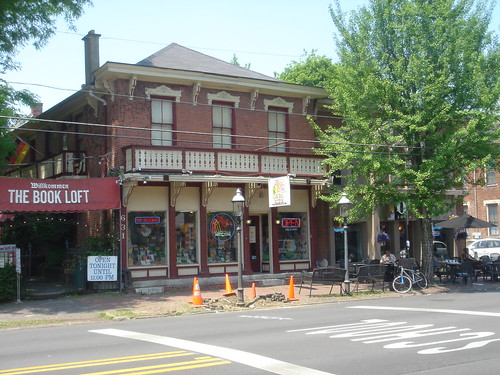


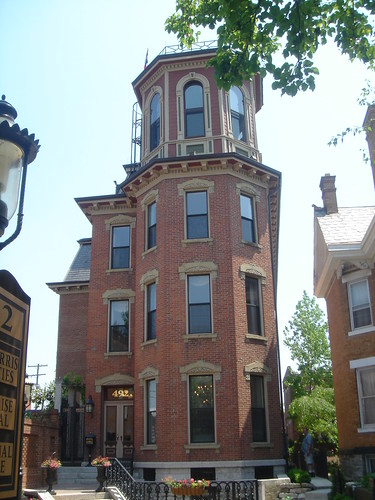
Here are some shots from the core of downtown. First the Ohio State House. Yup, no dome.
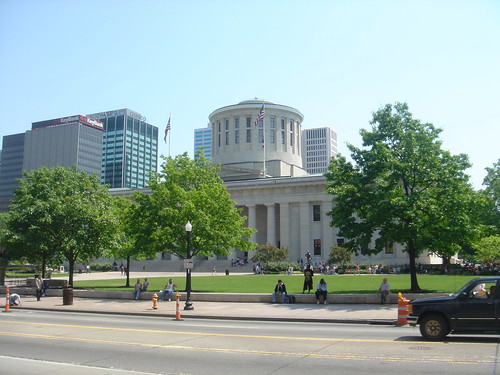
City Hall (I think)

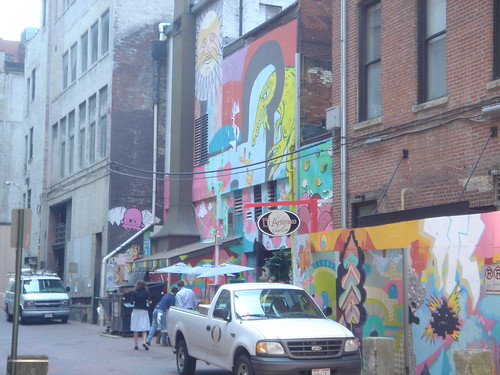
Moving a bit north to the Arena District. I like to call this Columbus' "Downtown 2.0". They got it wrong bigtime the first time around by trying to spread major projects like City Center Mall around in order to act as anchors. The right approach is clustering multiple types of uses in a single district, which the city did right in the Arena District.
The downtown arena is named for Nationwide Insurance, which is the prime mover behind much of the downtown redevelopment.

The Columbus Convention Center. I'm not sold on the architecture, frankly, though they made an effort to do something other than the standard box.
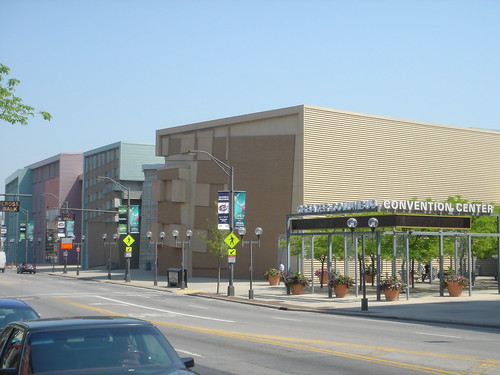
Restaurants in the vicinity.

Nationwide's funky headquarters. I've always thought buildings like this have a bit of an Orwellian aura about them. It looks like some Eastern Bloc country's defense department.

Moving along to the north, we get to to a neighborhood called the Short North. The one photo I have of it in my archives doesn't do it justice. Lots of arts related businesses here.
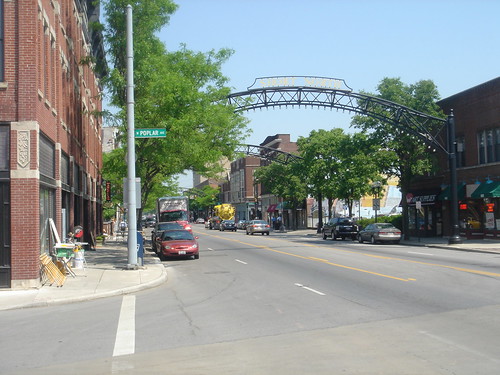
One of those old moneyesque suburbs I mentioned is Worthington in northern Franklin County. Here are a couple snaps.
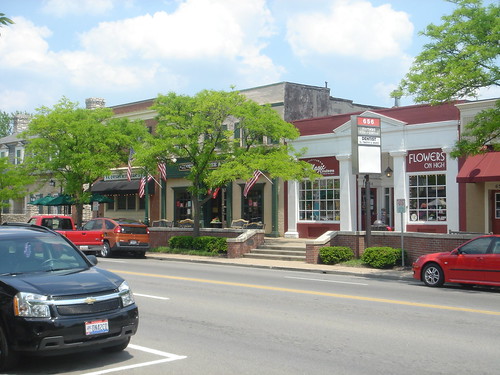
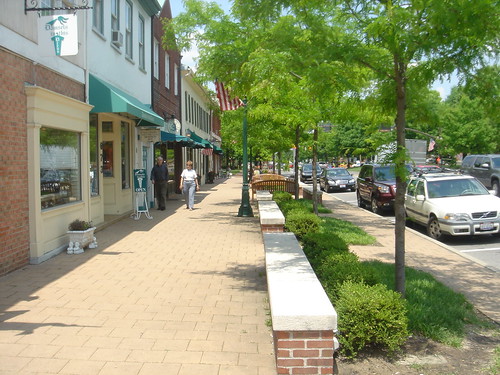
The main street in north suburban Delaware, the eponymous county seat of the fast growing county in Ohio.
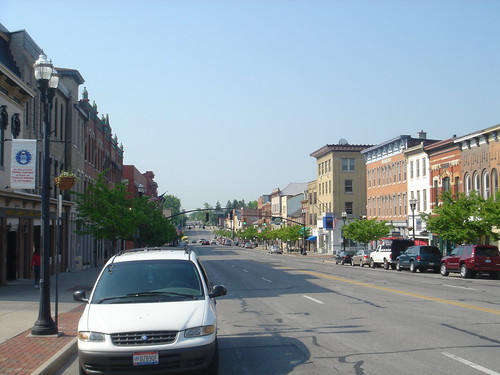
My take on more Midwest cities:
Chicago: A Declaration of Independence
Cincinnati: A Midwest Conundrum
Cleveland: What's Wrong?
Detroit: Do the Collapse
Louisville: An Identity Crisis
Thoughts on branding from Indianapolis that are relevant to Columbus, as well as a concept brand positioning for Louisville
The Brand Promise of Indianapolis
Our Product is Better Than Our Brand
Louisville: Vice City
Thoughts on Urban Design that are relevant to Columbus
15 Quick, Easy, and Cheap Ways to Make a Big Urban Design Impact in Indianapolis
The Streetlights of Chicago
Thoughts on the elements of good economic development strategies. Again, Indy focused, but applicable anywhere.
What is a Strategy?
Amateur Sports
Motorsports
Music Crossroads
Indianapolis Museum of Art
Link to original post
